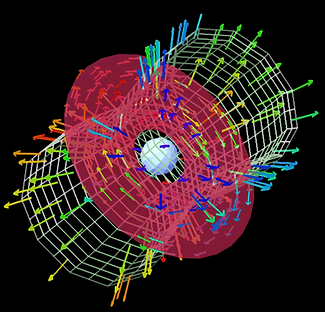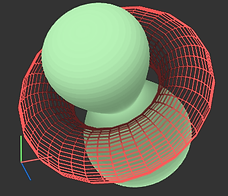.
Overview
Your first question is likely to be:
Is Shape suitable for my modeling problem?
Here is a short summary of the types of problems that have been worked on with Shape and others for which we know that the software can be used. We shall also discuss the limitations that might prevent your problem to be attacked with Shape.
General considerations:
Polygon meshes:
Polygon mesh objects are the most basic building blocks in Shape. The software generates them in a similar way as common 3-D animation programs such as the open-source Blender and many other commercial packages. However, these programs have been designed to model mostly opaque objects that surround us and hence compute their visual appearance according to the color assigned to their surface as a function of position and the lighting conditions. Only exceptionally volumetric effects are computed for clouds, fire or other phenomena that are not opaque.
In astronomy and astrophysics almost everything is about gas and dust clouds that are at least partially transparent. Real surfaces are very rare and can be found only on rocky planets and other solid bodies. Some stars can be considered to have "surfaces" since the transition from the optically thin to thick regimes is very small compared to their size.
The polygon meshes in Shape are therefore mainly used as containers of gaseous or dusty volumes, which are then assigned physical properties as a function of position within that volume rather than on the surface.

Computing Power:
An old saying claims:
"There is no such thing as too much computing power."
This is also true for Shape applications that wish to push the limits of what is possible. But for many scientific applications today´s power of almost any laptop suffices. Since Shape is a highly interactive software, for your own comfort and an effective workflow make sure to use a mouse instead of just the mouse-pad. More sophisticated devices such as graphics tablets are of additional benefit for some applications.
Most processes in Shape make use of parallel computing on multi-core CPUs. Especially the rendering processes and hydrodynamic simulations benefit from many-core CPUs and multi-threading.
While the benefit of parallel computing mainly lies in reducing the time required for a computation, memory influences the spatial resolution that can be achieved in a rendering or hydrodynamic simulation. So, if you have ambitions to produce high resolution photo-realistic visualization and animations, then you might want to use a high-end workstation. Individual images can be rendered at high resolution with a special HD renderer that does not require a lot of memory. It does, however, have to do the full rendering process for each image. When you only need to change the camera view point for an animation or time series, other renderers only need to redo the last rendering step, because they keep the pre-processing information in memory, thereby speeding up the process.
Batch processing can, at this time, not be done, e.g. as background processes on servers or supercomputers. This is a project for a future version.
Typical modeling applications for astrophysics
Morpho-kinematic modeling
The original design purpose of Shape was the modeling of the 3-D morphology of nebulae using as additional constraint the kinematics observed in spatially resolved high resolution spectroscopic data. As the structure becomes more and more complex, the traditional approach of direct coding of the volumetric density or emissivity as well as velocity distributions becomes impractical. Therefore the technology of interactive polygon mesh construction as volume containers was adapted to astrophysical needs from conventional 3-D modeling in Computer Graphics.
This type of modeling is still the flagship application of Shape. The user builds a 3-D volume distribution of density or emissivity, assigns a velocity field and then produces images, position-velocity diagrams and/or channel maps.
This is the main approach for modeling the structure and kinematics of circumstellar gas, be it expanding or rotating, such as in planetary nebulae, supernovae or proto-planetary disks. An extension of this methodology is the application of carbon-monoxide (CO) radiation transfer using the ShapeMol module. This is useful to model high-resolution observations with the ALMA or other radio interferometers.
A large number of scientific papers contains models of this type and can be referred to as examples. See the list of publications with Shape and Shape models.
Photo-realistic Models
Beyond scientific application ShapeX can be applied to produce photo-realistic visualizations of a variety of nebulas, stars, galaxies and other types of objects. This type of application often requires a mixture of various modeling techniques, using polygon meshes, particles and hydrodynamics. Since high spatial resolution and substantial model complexity is likely to be required for this type of application, substantially more computing power and processing time might be necessary compared to more basic applications. More detailed information and examples of photo-realistic models, in particular with mixed techniques that include polygon mesh and hydrodynamics can be found in Steffen & Koning (2017).

3-D hydrodynamics
The Hydro Module in Shape allows the simulation of basic astrophysical hydrodynamic phenomena at moderate spatial resolution (depending on the computing power in terms of CPU cores and RAM) solving the basic hydrodynamics equations. A simple radiative cooling scheme is included designed for fast computation above 10000 Kelvin. The details of the numerical scheme have been described in Steffen et al. (2013). The novel feature of the hydrodynamics in ShapeX is that the user does not require programming the initial conditions. For this task the interactive 3-D polygon modeling interface is applied. The full integration of the
hydrodynamic module in ShapeX allows a highly flexible analysis of the simulations and mixture with other modeling techniques. This yields very realistic visualizations for scientific and outreach applications.
If you have been using a hydrodynamics code that is not part of Shape and find that your visualization and analysis software does not meet your needs consider Shape for it. You can import data from hydrodynamic simulations and use Shape to generate spectral kinematic output (P-V diagrams, channel maps) and images for any viewing angle. It is also possible complement your model with additional features constructed with Shape´s polygon mesh techniques for scientific modeling or illustration, and much more.
Exoplanet transit lightcurves
The lightcurves of exoplanets are a rich research field for which Shape is very well suited using its animation module for setting up the orbital motion, the rotation of the star with star spots and limb darkening or brightening. Shape can not reconstruct the systems parameters automatically from data, but the user can construct not only the time series of a single transit, but automatically vary a number of parameters and setups that allow the construction of a catalog of transit lightcurves and corresponding videos that shows the transit together with the lightcurve. In addition to the scientific value, the movies can be of use for outreach and press release illustrations.


Schematic 3-D model illustrations
The 3-D polygon mesh models can be used for schematic illustrations of model ideas, even if you are not interested in a physical model. For papers and presentations such models can not only be static illustrations, but as interactive demonstrations or movies they can be powerful tools to convince an audience of one´s ideas.

Basic workflow:
Interactively add the geometric elements of your object in the form of primitive polygon meshes (Primitives) that you can access at the top menu bar of the 3-D Module. These meshes will serve to encase the volumes that will constitute the different parts of the model. Then you modify the simple structure of the Primitives using what we call Modifiers, which give the objects new geometric structure and physical properties as a function of position in space. Using the Physics Module, you then assign the material and radiation properties to the meshes. Finally, the model is rendered with the Render Module and some of the observational properties can be displayed with the (Channel) Maps and Graph Modules, where the observational data can be included and compared with the model results. If the results are not satisfactory, the model will be adjusted until a satisfactory match is found between observations and model.
Need a new Shape feature?
Don´t hesitate to contact us, we might be able to help either by finding a solution with the current software or implement a new feature for you, thereby helping other potential users with similar applications.
